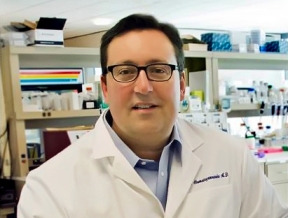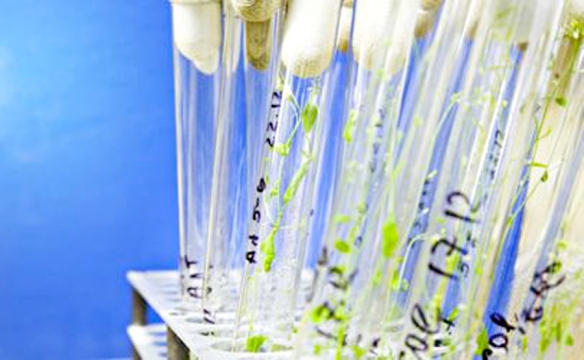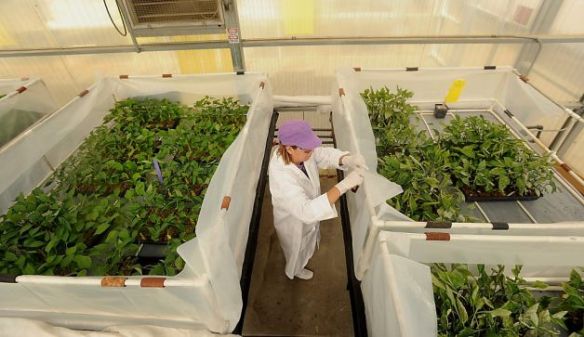One of the biggest assurances that pro-GMO manufacturers and scientists continue to make is how “safe” genetically engineered crops are. One of their primary arguments behind this assurance is that “new genes introduced in GM food are harmless, since all genes are broken up and rendered inert during digestion.”
Here are five studies disproving that theory…
The first study done in the U.K. indicates a potential release of genetically altered DNA in human digestive tracts: “the possibility of functional DNA release from plant GMOs cannot be excluded. The extent of the ability to natural transformation among intestinal bacterial species and strains is not known, although as a phenomenon natural bacterial transformation seems to be more frequent than hitherto recognised, and also intestinal pathogens might be transformable.” (Source: European Commission on Health and Consumer Protection; studying the effects of genetically engineered Brassica Napus or “rape” used in the production of rapeseed / canola oil.)
A second study done in China in early 2012 was much more sobering. It showed that ingested plant microRNA — such as the genetically modified bits containing Bt — not only survive digestion, but most definitely influence human cell function. This means that DNA can code for microRNA, which can, in fact, be hazardous… having been linked for ten years to human diseases including cancer, Alzheimer’s, and diabetes. Read the summary article here; view the original study report here.
 Photo caption: plant samples in the gene bank at CIAT’s Genetic Resources Unit, at the institution’s headquarters in Colombia. Creative Commons: Neil Palmer, CIAT, 2010 Source: Flickr
Photo caption: plant samples in the gene bank at CIAT’s Genetic Resources Unit, at the institution’s headquarters in Colombia. Creative Commons: Neil Palmer, CIAT, 2010 Source: Flickr
A third study in Norway, published in July 2012, proved that GMO genes are indeed transferred through the intestinal wall into the blood. During their study they found “pieces of genetically modified DNA in large enough segments to be identified in blood, muscle tissue and liver.”
Not only did that Norwegian study once again disprove the long-held “pro-GMO” claim that “new genes introduced in GM food are harmless since all genes are broken up in the intestines,” the test animals also showed increased weight gain, increased appetite, decreased immune function, an inability to properly digest proteins, as well as a different intestinal microstructure. (If this sounds like most of the U.S. population, it’s no wonder Monsanto and the Grocery Manufacturers Association don’t want labeling approved in this country.)

Professor Jack Heinemann (above) says more work is needed to determine the link between dsRNA and assorted undiagnosed low-level diseases throughout the Western world.
In October 2012, a fourth study done at the University of Canterbury in New Zealand reinforces the “altered genes survive digestion” theory. In this study, Professor Jack Heinemann found that the double stranded RNA (dsRNAs) present in genetically engineered wheat were able to withstand digestion (even after cooking) and circulate throughout the body, where the RNA amplified into more and different dsRNAs and “alters gene expression in the animal.”
The scientist went on to state: “The molecules created in this wheat, intended to silence wheat genes, can match human genes, and through ingestion, these molecules can enter human beings and potentially silence our genes. The findings are absolutely assured. There is no doubt that these matches exist.” Read a synopsis article here; view the full study report here.

Cumulative distribution of plant DNA amount for over 900 subjects
In July 2013, the most recent study done by Hungarian scientists proves it once again: “Based on the analysis of over 1,000 human samples from four independent studies, we report evidence that meal-derived DNA fragments which are large enough to carry complete genes can avoid degradation, and through an unknown mechanism, enter the human circulation system.”
If these altered genes aren’t digesting, what’s the inherent risk?
These studies indicate that the food we eat transfers more than just vitamins and proteins to our cells. Our bodies are absorbing information in the form of microRNA.
What’s the purpose of microRNA? They usually function by turning down or shutting down certain genes. What genes would you like to have “turned down or turned off” in your body, without your knowledge or permission?

How about genes from salmon that have been genetically engineered to grow faster and larger than their natural counterpart? (These salmon were recently approved for sale in Canada; here in the U.S. the approvals are stalled…)
How about genetically engineered wheat developed by an Australian biotech company (CSIRO), which, had it been approved, would have been able to silence human genes, resulting in premature death and risk of passing the defect on to future generations?
And what if the impacts of genetic modification are far more than the scientists ever realized, because scientists are still discovering how DNA actually works?
 Recent Discovery: DNA contains “hidden” code
Recent Discovery: DNA contains “hidden” code
In a December 2013 study, scientists at the University of Washington discovered a second code “hiding” inside DNA, which completely changes how scientists read the instructions contained in DNA, and how they interpret mutations to make sense of health and disease.
According to the lead scientist (Genome scientist Dr. John Stamatoyannopoulos at the University of Washington, pictured above), “The fact that the genetic code can simultaneously write two kinds of information means that many DNA changes that appear to alter protein sequences may actually cause disease by disrupting gene control programs or even both mechanisms simultaneously.” – Dec. 13 issue of Science.
 Geneticist David Suzuki (pictured at left) has been saying the same thing for years: “One small mutation in a human being can determine so much. Even if you move one tiny gene out of an organism into a different one, you are completely changing its context. There is no way to predict how it’s going to behave and what the outcome will be.”
Geneticist David Suzuki (pictured at left) has been saying the same thing for years: “One small mutation in a human being can determine so much. Even if you move one tiny gene out of an organism into a different one, you are completely changing its context. There is no way to predict how it’s going to behave and what the outcome will be.”
Are you comfortable being part of the experiment?
.
—
© GMO-Awareness.com, 2011–2014. Unauthorized use and/or duplication of this material without express and written permission from this blog is strictly prohibited. Excerpts and links may be used, provided that full and clear credit is given to GMO-Awareness.com with appropriate and specific links back to the original content.



Reblogged this on "OUR WORLD".
Huh, just how does our intestines know which genes are the GM genes to let through into the bloodstream while blocking the rest?
Our intestines are not selectively choosing which DNA to pass through, we’re sorry if the article was confusing. All DNA from the foods we eat have the potential to survive digestion — whether genetically engineered or not. Because genetically engineered food contains foreign DNA (typically from bacteria and viruses such as E. Coli), and because the process of forcefully inserting this foreign DNA into plants has been proven over and over to cause a spiraling effect of unintended consequences to the genome, this article is another case in point for avoiding genetically modified crops / ingredients made from these crops (which are most commonly found in processed non-organic food and feed used for non-organically raised meat animals). Feel free to read more about the inherent risks of genetically engineered food here >
Reblogged this on Vegan Harmony and commented:
Very interesting… I try to tell people that GMOs are bad but just saying we are guinea pigs for something not really tested wasn’t enough. Here is some awesome information on why GMOs are bad!
Reblogged this on teamrich.wordpress.com and commented:
Genetically Modified (GM) Foods are not as harmless as claimed by their pro-GMO proponents.
Ummm, everything we eat has genes in it. If the artificial genes we insert into plants can enter our cells (which I highly doubt) than so can the genes that already occur naturally in the wheat.
This article does a very effective job of highlighting the fact that genetic material from biotoxins in GMO food can indeed get into the blood and thus into our cells and mess with our own DNA, just as the genetic material from viruses do the same thing which can kill us. Think Ebola and many other illnesses caused by organisms that recode our cellular replication systems.
So why should we believe, per Monsanto, that “their” GMO genetic material somehow never enters the blood stream intact, let alone entering our living cells. They are not just manipulating the molecular orientation of a substance like sugar, they are manipulating the living genetic code of organisms that can enter our cells, still “alive” which are then capable doing great harm to the entire body, whether planned that way or not.
Then add insult to injury, Monsanto, and sue the the pants off of farmers who even so much as accidentally discover GMO plants on their property. On and on it goes. It is a corporate attempt to control the global food-stream for profit, or worse the control of health of living beings. Lies about greater productivity (crop yields) are baseless and unprovable due to so many other variables such as weather. If there is verifiable data, we’d like to see it!
Monsanto’s government arm, the FDA, naturally supports whatever Monsanto needs in the way or approvals and protection from consumers knowing the truth about the risks of GMO genes and other molecules destroying the normal function of cells. What blatant conflict of interest to have so many “ex-Monsanto” officials in charge of the FDA. Sort of like Rumsfeld and Searle’s Nutrasweet scam.
I have changed my position on my above statement about living genetic material entering our blood stream and cells.That may not be corect except perhaps for viral or bacterial infections. The exception might be if toxins introduced in the GMO manufacturing process can damage our cellular material in some way, as it is capable of doing apparently in “pest and pesticide control”. More data is needed. Open, reliable, clear data that says yes or no that GMO is absolutely safe for animal (human) consumption and is nutritionally equivalent in all respects.
So why are meat eaters not turning into cows or growing feathers from eating chickens ?
Science and Biology 101
Dear cmi, the article and the science behind it, arent implying that you turn into that which u eat. They are outlining that very little is known about dna modification, and that, contrary to claims made by the gmo industry, the dodgey dna-modified spirals dont just get flushed thru our body. In fact they get absorbed into our systems and will be likely passed onto our kids.
I do!
Pingback: Are you aware of the psychological impact on social media? | Christer Edman
Hey, I would like to know who wroted this article:)
Hey, someone really concerned about GMOs 🙂
I’m pinning on my Pinterest NO MORE GMO board .Thanks for the informative post!
Reblogged this on Living it Healthy with Antoinette.
Thank you for helping to raise awareness!
Thanks to all this the rates of Crohn’s disease are going through the roof. Look at all the new commercials for (Aline digestive help) . As well as probiotic pushes… The very people doing this to our food are eating it too and there kids. I can see the population no longer here if they keep this up.
If GMOs are potentially effecting and have been effecting our DNA, digestion, etc. for decades, how do we go about reversing that damage? I’ve been eating organic, taking probiotics, etc. now for a couple of years and my digestion is still messed up and am experiencing worsening results of auto-immune symptoms.
This is great information. I also want to know if our bodies killer cells attack this foreign DNA creating a constant inflammatory response, until this foreign DNA is destroyed.